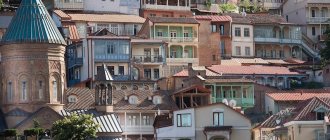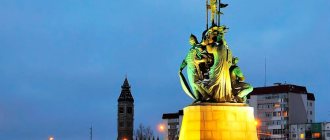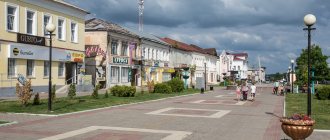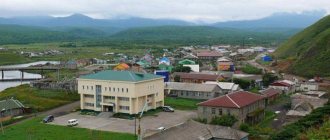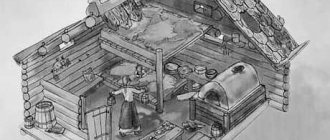Today Vyborg is a small medieval town on the shores of the Baltic Sea, located 130 km from St. Petersburg. It is distinguished by colorful houses, cobblestone streets and the famous fortress. Vyborg has always been more of a Western European than a Russian city, so even now it has a special atmosphere. Large-scale restorations have not been carried out here for a long time, so it is devoid of pomp and gloss, but this is the main charm of the romantic streets of old Vyborg.
Vyborg history of the city
Vyborg has been known since 1293, when the Swedes built a castle of the same name here. It received city status in 1403 and was an important Swedish fortification during the Northern War. Russian troops repeatedly wanted to take Vyborg, but only Peter I succeeded in 1710. The Swedes made several attempts to retake the city, but to no avail. The city remained with Russia. Gradually, the fortress lost its military significance and became more of a decoration of the city in the 19th century. reached its peak. At the beginning of the Soviet era, when Finland became an independent state, Vyborg became part of it. In 1940, during the Soviet-Finnish War, the city, and with it the entire Karelian Isthmus, was ceded to the USSR. For a short 3 years, from 1941 to 1944, Vyborg again became Finnish. From 1944 to the present, the city was part of first the USSR, and now Russia.
Accommodation options
When planning to thoroughly get acquainted with the local beauties, consider the possibility of spending the night in the city. Numerous guidebooks can tell you where to relax in Vyborg. Mostly apartments and hostels are available to guests, so you can safely hit the road without worrying about your budget. The price for one night near the center is only about 600 rubles when sharing a room with neighbors. You can rent an apartment and also have a kitchen at your personal disposal - it will cost approximately the same amount. But a full room in a hostel in the very heart of the city costs about one and a half thousand rubles.
Vyborg medieval castle
The main attraction of Vyborg is the medieval castle, from which the history of the city began in 1293. There are no other such well-preserved examples of Western European fortification art on the territory of Russia, which makes it unique. The ensemble was rebuilt several times, and in the 19th century a strong fire destroyed most of the complex. After it, at the end of the 19th century, restoration followed. Unlike many Russian landmarks, Vyborg Castle suffered little damage during World War II. And in 1970 a museum opened in it. Almost all the interior spaces are occupied by exhibitions. The center of Vyborg Castle is the tower of St. Olaf, the Norwegian saint, the baptist of Scandinavia. Its stone walls survived the fire of the 19th century and have reached us in the 16th century version. There is an observation deck on the tower, which offers an incredible view of the bay and the entire city.
First Settlers
The beginning of the official history of Vyborg dates back to the end of the 13th century. However, the place where the city now stands was not empty until that time. Until the second half of the 20th century, there were two versions about the first inhabitants of local lands. According to one of them, Vyborg is the brainchild of Novgorodians. The 17th century Russian historian Vasily Tatishchev retold the unsurvived Joachim Chronicle (8-9 centuries), which tells about the Novgorod elder Gostomysl. It was him who Tatishchev considered the founder of Vyborg:
“And when Gostomysl came to power... and build a city in the name of your eldest son, Choice, near Mori, make peace with the Varangians, and there will be silence throughout the whole earth.”
Despite the fact that the Russian Empire really wanted to find a Novgorod trace in the history of the founding of Vyborg, this version, like Gostomysl himself, is still considered fictional by modern historians.
According to another version, the ancestors of the Karelians (ancient Finns) were the first to inhabit the Vyborg lands. In the 10th and 11th centuries, settlers chose to live on a small island (now Castle Island), which had an excellent location allowing it to control the trade route from the Gulf of Finland to Ladoga.
At the end of the 20th century, archaeological excavations were carried out on Castle Island, the results of which confirmed the “Karelian” version. Traces of outbuildings and a sand embankment with a palisade, household utensils, weapons, and jewelry were found. All finds corresponded to the period of the 11th-13th centuries and indicated that a Karelian fort stood on this site.
The Karelians were peace-loving, had friendly relations with the Novgorodians and, together with them, traded with German and Swedish merchants. But the favorable location of the island played a fatal role in the fate of the settlement. The strategic advantages of this land interested the Swedes, and during one of the crusades, their northern neighbors attacked the fort.
Market Square.
The center of Vyborg, city holidays, festivals are held here, souvenirs are sold. The ensemble of the square is formed by buildings that once housed a branch of the Bank of Finland and the Central Market. One side of the square overlooks the bay of Salakka-Lahti, which contains a floating fountain. On the other side, it is adjacent to the Lenin Park (aka Park Esplanade).
Snack: tasty and affordable
Cafes and restaurants in the city are ready to serve the local population and guests literally around the clock. The choice is quite extensive - from small cafeterias and chain catering establishments to excellent restaurants providing high-quality service. When choosing where to eat in the center of Vyborg, you can look for more than just traditional Russian cuisine: there are plenty of restaurants serving Japanese and European dishes. A local specialty is the Vyborg pretzel, which to this day is prepared according to an ancient recipe invented by the Franciscans. You can pamper yourself with it in almost any coffee shop in the central part.
For tourists who don’t know where to eat in Vyborg, experienced travelers and local residents recommend paying special attention to the “Italian Yard”, the “U Knutsson” cafe and the “Myakish” bakery. Mostly interesting catering establishments are located in the center, many are decorated in medieval style. It’s rare where the check exceeds one and a half thousand rubles. The most economical options are public chain establishments. The classic representative is McDonald's, where you can eat a hearty meal for only 200 rubles. A business lunch in the city center or lunch in a cafeteria will cost approximately twice as much.
Round tower on the market square.
The main decoration of the Market Square is the Round Tower, built in the 16th century. It remains from the fortifications of old Vyborg. The tower is famous for the fact that at the very beginning of the 17th century the “Vyborg Treaty” was signed here between Charles IX from Sweden and Vasily Shuisky from Russia. According to this document, Sweden helped Russia fight the Poles, and Russia gave Sweden the Korelu fortress. Today the building houses the Round Tower restaurant.
Vyborg. Stone city.
In Vyborg, the ruins of the Fortress Wall (also called the Stone City) have been preserved: it was built in the 15th century and protected the city until the 19th century. The city was developing, and the fortress wall interfered with this, so it was dismantled, leaving only part of the buildings. Part of the wall is the Round Tower, as well as the Town Hall Tower. Its history is not simple. After the loss of its defensive function, it was both an arsenal and a cathedral bell tower. It was rebuilt several times, burned and restored. It came down to us in an edition of the late 18th century.
Weather
Vyborg is usually several degrees colder than St. Petersburg. It has a humid maritime climate that transitions to continental. The weather is influenced to some extent by the Gulf Stream. The lowest temperature in winter was −38 °C, the highest in summer was +33 °C. But such a spread does not happen every year. Vyborg is usually damp, moderately cool and slightly windy. In summer you can see the famous white nights here, just like in St. Petersburg.
Bastion Panzerlax
The surviving buildings of the Stone Town include the Panzerlax bastion, built at the end of the 16th century as part of the Horned Fortress. The name of the bastion is translated as “shell of the bay.” Now the building houses the Panzerlaks cafe. You can also see the remains of earthen fortifications on the streets with the telling names Northern Wall and Southern Wall.
Clock tower in Vyborg
Clock tower. The tower is one of the symbols of Vyborg. It was built at the end of the 15th century and was the bell tower of the cathedral destroyed during the Soviet-Finnish war. The clock was installed here only 200 years later. The tower acquired its modern appearance after a fire in 1793 - it was rebuilt and made higher. Catherine II gave the city a bell, which still hangs on the tower. Tourists will also be interested in seeing the Transfiguration Cathedral, the Lutheran Church of Saints Peter and Paul, the Church of Elijah the Prophet and the Baptist “Church on the Rock”.
For those who love convenience
Experts recommend planning where to stay in Vyborg in advance - many hotels regularly have sales, and discounts reach 70%. This is especially beneficial if you want to stay in a medium or high-level establishment. A room for two will cost from 2,500 rubles and above, and this amount also includes breakfast. The highest quality service will require a payment of about five thousand rubles per room. For the same money you can rent luxury apartments designed for a group of up to five people inclusive. The Vyborg Hotel is currently considered one of the best.
Vyborg how to get there.
There are several ways to get into the city: By car on the A181 highway in the direction of Helsinki. Distance 130 km, travel time about two hours. By train or express train from Finlyandsky Station. The train takes about 2.5 hours, the express train takes about 1.5. To purchase an express ticket you will need a passport. By bus from the Northern Bus Station in Murino (Devyatkino metro station), or from the bus station near the Parnas metro station. You can also purchase tickets for buses going to Helsinki via Vyborg. They depart not only from bus stations, but also from the Ozerki and Chernaya Rechka metro stations, or pick up a tourist from a designated address. Tickets are more expensive, but comfort is usually higher.
General overview
Any more or less detailed map will tell you where the city of Vyborg is located. This is a regional center in the Leningrad region, approximately 130 kilometers away from the Northern capital in the northwest direction. Currently, the settlement is one of the resort towns. Its location is unique: Vyborg is built on the Karelian Isthmus, right on the shore of the Gulf of Finland. The mouth of the Saimaa Canal is also located here, through which ships can sail between the two powers. It’s surprising, but you can get to Vyborg by boat without going onto land, even from such distant places as Northern Savonia (a province in northeastern Finland). This is due to the complex, rich system of reservoirs connected to the Baltic Sea.
Where is the city of Vyborg? It’s really worth knowing the answer to this question if you plan to travel around Karelia or the Leningrad region, St. Petersburg. The settlement has a long history, so visiting it will be interesting for both adults and children. Local residents are proud of the unique ancient monuments erected back in the thirteenth century. The Old Town looks attractive, preserving the romantic atmosphere of the European Middle Ages. Particularly noteworthy is Monrepos, a park famous for its beautiful landscapes and magnificent manor house built in the nineteenth century.
